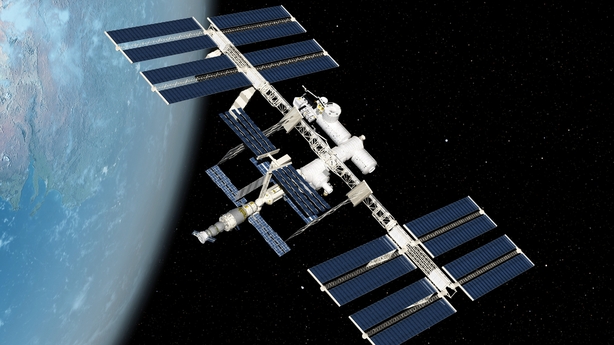The US space agency NASA has contracted SpaceX to help discard the International Space Station (ISS) around 2030, a task originally meant to be carried out by Russian equipment.
NASA awarded SpaceX $843 million (€787m) to build a vehicle capable of pushing the ISS into Earth's atmosphere for its planned destruction.
Under the contract, Elon Musk's company will build a vehicle to deorbit the space station and avoid risks to populated areas, with NASA taking ownership of the craft and handling the operation.
The planned retirement date for the ISS has been set for 2030 because of its ageing components.
The United States Japan and Canada, as well as countries under the European Space Agency, have committed to the space station partnership until 2030.
Russia has agreed to remain a partner until 2028, the date at which the Russian space agency Roscosmos believes its hardware will stop working.
The scientific cooperation aboard the ISS, orbiting around 400km above Earth, has survived years of geopolitical strife, including Russia's war in Ukraine that has ended nearly all other cooperative ties between Moscow and the western world.

Holding the US-Russian alliance together is largely a technical interdependency in which Russia's equipment maintain the station's orbital altitude while US solar columns keep its power running.
The Russian parts were originally meant to push the ISS into Earth's atmosphere at the end of its life.
But, in recent years, NASA sought its own deorbit abilities should Russia bow out of the alliance earlier than planned or become unable to do the task itself.
The US plan was accelerated in recent years as the White House and other government bodies pressured NASA to make contingency plans amid souring relations with Russia.
For after 2030, NASA has been funding early development of privately built space stations in low-Earth orbit to maintain US presence in the cosmic region, with Airbus and Jeff Bezos' Blue Origin involved in those efforts.
Though the market for private space stations is not fully understood, US officials believe a commercial ISS replacement is crucial to compete with China's newer space station in low-Earth orbit.
NASA and China are both racing to the moon.
The US space agency is investing billions of dollars, partnering with several countries and companies including SpaceX to return the first humans to the moon since 1972.
Russian satellite breaks up in space, forces ISS astronauts to shelter
A defunct Russian satellite has broken up into more than 100 pieces of debris in orbit, forcing astronauts on the International Space Station to take shelter for about an hour and adding to the mass of space junk already in orbit, according to the US.
There are no immediate details on what caused the break-up of the RESURS-P1 Russian Earth observation satellite, which was declared dead in 2022.
US Space Command, tracking the debris swarm, said there is no immediate threat to other satellites.
The event took place at around 5pm Irish time yesterday, it added.
It happened in an orbit near the space station, prompting US astronauts on board to shelter in their spacecraft for roughly an hour, NASA's Space Station office said.
Russia's space agency Roscosmos, which operated the satellite, did not respond to a request for comment.
Radars from US space-tracking firm LeoLabs detected the satellite releasing several fragments for around eight hours, the company said.
US Space Command, which has its own global network of space-tracking radars, said the satellite immediately created "over 100 pieces of trackable debris".
Large debris-generating events in orbit are rare but of increasing concern as space becomes crowded with satellite networks vital to everyday life on Earth, from broadband internet and communications to basic navigation services, as well as satellites no longer in use.
Russia sparked strong criticism from the US and other western countries in 2021 when it struck one of its defunct satellites in orbit with a ground-based anti-satellite (ASAT) missile launched from its Plesetsk rocket site.
The blast, testing a weapon system ahead of Moscow's 2022 invasion of Ukraine, created thousands of pieces of orbital debris.
What happens to old satellites?
Dead satellites either remain in orbit until they descend into Earth's atmosphere for a fiery demise years later, or in widely preferred - but less common - circumstances they fly to a "graveyeard orbit" some 36,000km from Earth to lower the risk of crashing into active satellites.
Roscosmos decommissioned RESURS-P1 over onboard equipment failures in 2021, announcing the decision the following year.
The satellite has since appeared to be lowering its altitude through layers of other active satellites for an eventual atmospheric reentry.
The six US astronauts on the space station were alerted by NASA mission control in Houston early today to execute "safe haven" procedures, where each crew member rushes into the spacecraft they arrive in, in case an emergency departure is required.
NASA astronauts Butch Wilmore and Sunni Williams boarded their Starliner spacecraft, the Boeing-built capsule that has been docked since 6 June in its first crewed test mission on the station.
Three of the other US astronauts and a Russian cosmonaut went into SpaceX's Crew Dragon capsule that flew them to the station in March.
The sixth US astronaut joined the two remaining cosmonauts in their Russian Soyuz capsule that ferried them there last September.
The astronauts emerged from their spacecraft roughly an hour later and resumed their normal work on the station, NASA said.
The prospect of satellite collisions and space warfare have added urgency to calls from space advocates and lawyers to have countries establish an international mechanism of managing space traffic.

